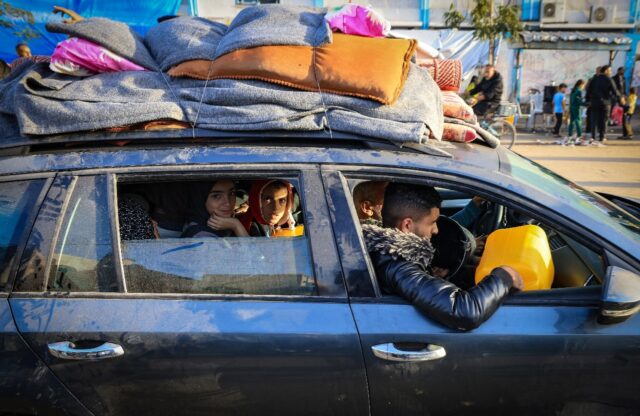After 48 days of gunfire and bombardment that claimed thousands of lives, a four-day truce in the Israel-Hamas war began on Friday with hostages set to be released in exchange for Palestinian prisoners.
The truce, from 7:00 am (0500 GMT), triggered a mass movement of thousands of Gazans who had sought refuge in schools and hospitals from relentless Israeli bombardment begun after unprecedented attacks on October 7 by Hamas militants.
“I’m going home,” Omar Jibrin, 16, told AFP after he emerged from a hospital in the south of the Gaza Strip where he and eight family members had sought refuge.
In Khan Yunis, in southern Gaza where many Palestinians fled, a cacophony of car horns and ambulance sirens has replaced the sound of war.
For Khaled al-Halabi, the truce is “a chance to breathe” after nearly seven weeks of war that began when Hamas broke through Gaza’s militarised border to kill, according to Israeli officials, about 1,200 people and seize around 240 Israeli and foreign hostages.
Israel’s retaliatory air, artillery and naval strikes alongside a ground offensive have killed about 15,000 people, the Hamas government in Gaza said.
“I hope the truce will take effect throughout the Gaza Strip so I can see my destroyed house and what’s left of it,” said Halabi, who took refuge in Rafah but is from Gaza City in the north, much of which has been reduced to rubble.
Aid enters
Gazans like Halabi have struggled to survive with shortages of food, water and fuel. Trucks carrying more aid, including fuel, began moving into Gaza from the Rafah crossing with Egypt shortly after the truce began.
The agreement came after weeks of talks involving Israel, Palestinian militant groups, Qatar, Egypt and the United States.
As part of the deal, 13 women and children held hostage in Gaza are due to be freed at 4:00 pm, followed by a number of Palestinian prisoners from Israeli jails, according to Qatari mediators.
Over the four days, at least 50 hostages are expected to be freed, leaving an estimated 190 in the hands of Palestinian militants.
In exchange, 150 Palestinians prisoners are expected to be released.
According to the United Nations, 1.7 million of Gaza’s 2.4 million people are estimated to have been displaced by the fighting.
Now, thousands of them are trying to get home.
In Khan Yunis, they loaded belongings onto carts, strapped them to car roofs, or slung bags over their shoulders, crowding streets to return to their homes in the city’s east after leaving their war shelters.
Israeli warplanes over southern Gaza dropped leaflets warning people not to head back to the north.
“The war is not over yet,” the leaflets read. “Returning to the north is forbidden and very dangerous!!!”
Around 15 minutes after the truce began, sirens warning of incoming rockets sounded in several communities along Israel’s border with Gaza, the Israeli military said, without providing further details.
In the morning, a few apparent gunshots could be heard and dark plumes of smoke rose periodically over northern Gaza, an AFPTV livecam showed, but the truce appeared to be holding.
Further north, on the Lebanon-Israel border, calm also returned after regular deadly exchanges of fire, primarily between the Israeli army and Hezbollah. The Lebanese movement, like Hamas, is backed by Iran.
Qatari officials said the “first batch” of 13 hostages released would be women and children from the same families.
Speaking to AFP on condition of anonymity, a Hamas official said the captives would be freed “by 4:00 pm at the latest”.
Carefully scripted
Israeli soldiers are being carefully prepared to receive potentially deeply traumatised women and child hostages. Even the first words the soldier-escorts will say have been carefully scripted. They have also been encouraged to carry the child’s favourite food.
An Egyptian security source told AFP that Israeli security officials, International Red Cross-Red Crescent staff and an Egyptian team would deploy to Rafah, on the Egypt-Gaza border, to receive the hostages, who would then be flown to Israel.
AFP has confirmed the identities of 210 of the roughly 240 captives.
At least 35 of those taken hostage were children, with 18 of them aged 10 or under at the time of the Hamas attack.
Four female hostages have already been released by Hamas and Israeli forces rescued one female soldier. Two other captives, including a woman soldier, were found dead by Israeli troops in Gaza.
The office of Israeli Prime Minister Benjamin Netanyahu said it had received “a first list of names” of those due to be released and been in contact with the families. It did not specify who was on the list.
Maayan Zin, whose eight- and 15-year-old daughters Ela and Dafna are also among the hostages, posted on X, formerly Twitter, that she had been informed their names were not included.
“This is incredibly difficult for me; I long for their return,” she wrote.
Asked if he expected kidnapped American toddler Abigail Mor Idan to be in the first release, US President Joe Biden said: “I’m keeping my fingers crossed.”
Palestinian prisoners held in Israeli jails will also be freed on Friday, Qatari foreign ministry spokesperson Majed Al Ansari said, adding a list of names had been approved.
The agreement entailed a “complete ceasefire with no attacks from the air or the ground” and the skies clear of drones to “allow for the hostage release to happen in a safe environment”, Ansari said.
Palestinian prisoners will be released from three jails in Israel and the Israeli-occupied West Bank, then taken to the Ofer military camp on buses, an Israeli official told AFP on condition of anonymity.
Governments around the world welcomed the agreement, with some expressing hope it will lead to a lasting end to the war.
Israeli officials, however, say the truce will be only temporary.
burs-it/dv

COMMENTS
Please let us know if you're having issues with commenting.